Hello, my dear Steemians!
I'm again here with another task. In the wake of carefully describing the example of Crypto Trading With Williams % R Indicator here, I am presenting my homework. The expectation is up to the necessary norm. Thanks to professor @kouba and @yohan2on for the amazing lesson.

Explain the Williams %R indicator by introducing how it is calculated, how it works? And what is the best setting? With justification for your choice.
The WPR indicator, Williams %R or Williams percent range indicator, is an oscillator type indicator which traders use to gain the strength or shortcoming of a market, that is if the market is overbought or oversold, permits to know the energy marker that a few financial backers use to discover section and leave focuses for their positions. It is an ideal pointer for side business sectors that was established by Larry Williams, this being his most renowned device known.
The indicator estimates how near the high or low of given period prices have shut in the last meeting. In the first place, the financial backer picks the period, for instance, 10 meetings, and thusly, the marker will tell us if the end of the last meeting is close or not to the most extreme or least that the worth set apart in those 10 days.
At the point when executed inside business sectors, this shows that the way that in the last meeting the nearby is near the limit of the most recent 10 days, could demonstrate that the cost of the resource is near an opportunity to pivot and return. Likewise, if the end of the last meeting is near the low of the most recent 10 days, the worth is probably going to turn higher as it is near finishing the selling pressure.
The broker can design the period to his longing, nonetheless, the time of 10 days is suggested by Larry Williams, albeit initially, he had considered 10, something like 10 days is likewise an awesome reference, it is around two entire weeks, it says a half month, so my legitimization for utilizing the 10-time frames is that I feel that it is a blend between the short and medium-term, which will assist me with breaking down and know the excellent passage and leave focuses.
The qualities of the pointer range from 0 to – 100, when 0 addresses an overbought market and – 100 an oversold market. Financial backers will commonly take a move above – 20 to 0 as a sign that a hidden market is overbought and a move beneath – 80 to – 100 as a sign that the market is oversold. The computation of the marker is given by the accompanying recipe:
Williams % R = (NHigher - Closed)/(NHigher - NLower) * (- 100)
Where NHigher is the greatest cost reached during the investigated period, NLower the least and shut the last cost, or shutting cost, for the broke down period.
This will give us a worth between - 100 and 0, and will assist us with interpreting the setting of the resource and the overbought and oversold signals, as well as could be expected passage or leave signals.
As I would like to think, I consider that it is a genuinely complete oscillator pointer at the level of the data that it can give us (even though it gives us many signs), which consistently must be enhanced with different markers, as we push ahead with the article we will clarify their understandings, conceivable use cases, focuses to consider, how to work on the marker to stay away from bogus signs, and how to utilize the dissimilarity rates.
Later in this article, we will perceive what are the best situations for this indicator, which happens when we wind up in a uniqueness either bullish or negative, or when we supplement with another marker, for instance, the EMA to affirm and channel signals. A situation with these two qualities could be an excellent situation without a doubt.
How do you interpret overbought and oversold signals with The Williams %R when trading cryptocurrencies?
The Williams percent range is identified as an oscillator since it goes from 0 to -100, and between these qualities decide the overbought and oversold level of a resource. At the point when the W%R is between -80 and -100, the market is supposed to be at an oversold level, and when it's between -20 and 0, it's viewed as overbought

From the picture above, we can see that when the chart is among 0 and - 20, the cost of the resource began descending, which implies overbought, and simultaneously when it was between - 80 and - 100, the value turned around and begin moving back up, and this represents oversold. Yet, we should not rapidly choose to purchase or sell when we see that a market is at an oversold or overbought level. We should sit tight for an affirmation before we enter the market. If the market is at an overbought level, we should hang tight for it to decay before selling. The equivalent is relevant to oversold. We should sit tight for an indication of bullish development before we purchase.
What are "failure swings" and how do you define it using The Williams %R?
The "failure swing" is an example where the marker doesn't cross the risk zone, for example, doesn't go over the - 20% in a bullish pattern and takes inversion. This inversion without the intersection of the high reference line demonstrates the shortcoming in the pattern and gives a sell signal. Additionally in negative development, on the off chance that it neglects to cross the - 80% level and take inversion shows the shortcoming in the pattern and gives a buy signal.

In the above diagram of FTM/USDT 4h "failure swing" is noticed and it shows the shortcoming of the pattern. The indicator didn't go above - 20% and take inversion and the pattern additionally becomes down from a vertical pattern. This sign can be utilized to start a trade.
How to use bearish and bullish divergence with the Williams %R indicator? What are its main conclusions?
Divergence is a circumstance when the value development of a resource is heading the other way of the indicator utilized. At the end of the day, uniqueness happens when there is a descending value development of a resource and a vertical development of the WPR line as well as the other way around. Divergence is for the most part used to flag a pattern inversion.
Bullish Divergence With WPR Indicator
The bullish divergence with WPR pointer happens when the cost of the resource is moving downwards and the WPR line is moving upwards. A bullish pattern inversion in the cost of the resource will happen after the dissimilarity. Check out the picture beneath for seriously understanding.
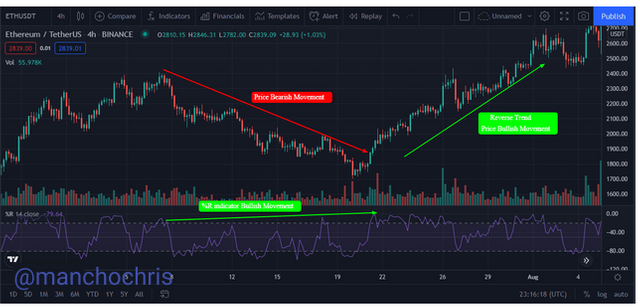
Bearish Divergence With WPR Indicator
The bearish divergence with WPR indicator happens when the cost of the resource is moving upwards and the WPR line is moving downwards. A negative pattern inversion in the cost of the resource will happen after the divergence. Check out the picture beneath to follow up more.
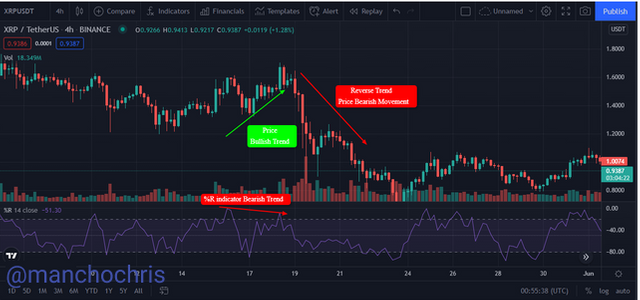
How do you spot a trend using Williams %R? How are false signals filtered?
To recognize a pattern we need to search for the most noteworthy uncovering highs and the most elevated lows that propose an upturn, and in the closely resembling case, the least lows and the least highs that recommend a downtrend.
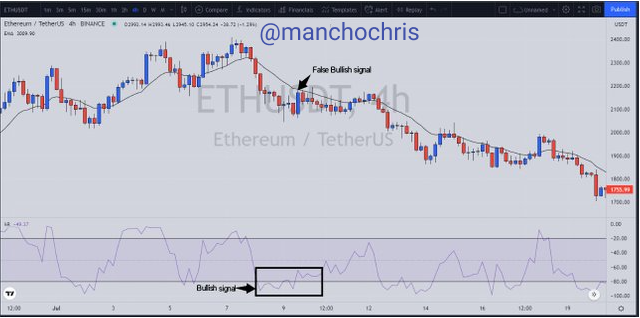
At the point when the Williams %R pointer is above - 80%, in an overbought condition, it proposes that we are in a solid upswing, and beneath - 20%, due to the oversold condition, then, at that point, it will be a solid downtrend.
Notwithstanding, when the Williams %R pointer rises or falls without going above - 80% or - 20% to affirm the pattern, we enter a zone with a more noteworthy possibility of bogus signals. That is the reason, as the teacher referenced in his article, we utilize moving midpoints, where when beginning an ascent or fall, whenever said EMA goes with the marker while affirming the sign, and it will assist us with separating bogus signs, just as consider as a passage or leave signal.
Set the EMA with a similar time of days as the Williams %R pointer setting, for my situation I consider a 14 period EMA very much like the WPR. Again in the BNB - USDT outline in Trading View underneath, we can see that after the cost surpasses - 20%, the EMA then, at that point, affirms the sign and that a value rise will for sure come.
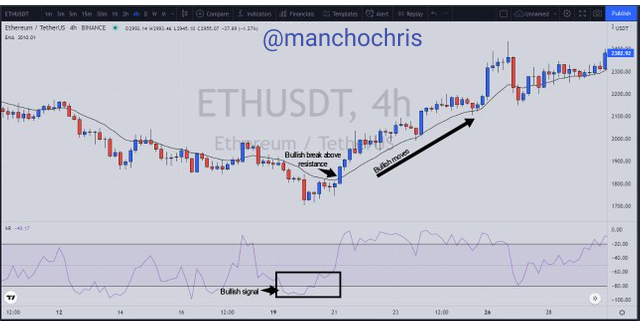
Use the chart of any pair (eg STEEM/USDT) to present the various signals from the Williams %R indicator.
All through the article, I introduced different signs from the Williams %R marker to clarify each point, we will see a little outline with a similar BNB - USDT diagram in Trading View. It is worth focusing on that the period is set for 14 days for the WPR, the equivalent for the EMA.
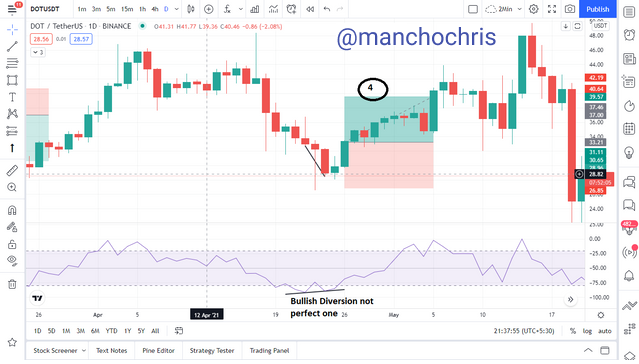
In this diagram, we would first be able to look to the left when the Williams %R marker lets us know that the cost of BNB is oversold, which is an indication of a potential purchase.
Later on, we get a failure swing, where the indicator doesn't begin to rise, surpassing - half, yet without arriving at its reference greatest above - 20%. Later the value falls, starting to enter an oversold zone beneath - 80%, nonetheless, as the educator referenced in his article, on the off chance that we expect a superior sign from the EMA that we have designed with a similar period than WPR, we can exploit making a buy with a lower cost.
At long last, toward the end, the marker gives signs of overbought, and the value keeps on rising, staying for a happy time frame above - 20%, in this way, a decent procedure is to make the deal not eventually above - 20%, but rather when the pointer starts to decay underneath - 20%, and leaves the overbought zone.
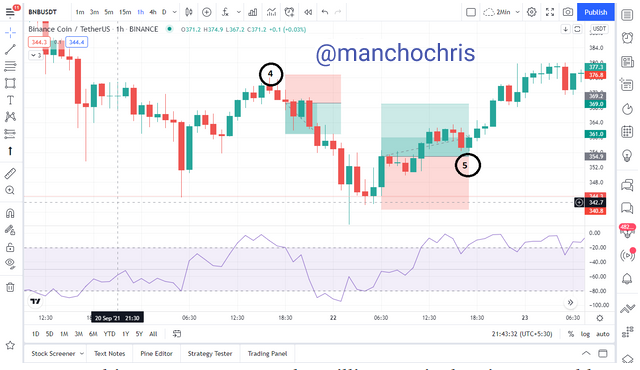
Conclusion.
Williams Percentage Range indicator is genuinely an excellent oscillator that helps traders realize when to anticipate a negative pattern, bullish pattern, and pattern inversion. On the whole, it is an awesome indicator for traders to use close-by an affirming pointer like the Moving Average(MA) marker, to foresee patterns course more successfully.
At long last, an experienced trader knows very well that you can never utilize a solitary indicator, yet supplement it with a few indicators that permit us to affirm and have more prominent certainty to play out an exchange, the Williams %R marker can create many signs, in have a decent practice with various markers, this is supplemented, sifted and permits us to have excellent data about it.
Hello @manchochris,
Thank you for participating in the 4th Week Crypto Course in its 4th season and for your efforts to complete the suggested tasks, you deserve a Total|7/10 rating, according to the following scale:
My review :
An article with good content in general, as you managed to clearly answer most of the questions.Your explanation of the indicator was comprehensive and touched on all its characteristics.
Thanks again for your effort, and we look forward to reading your next work.
Sincerely,@kouba01
Downvoting a post can decrease pending rewards and make it less visible. Common reasons:
Submit
Thank you Prof. @kouba01 for the cool lesson and for the warm feedback.
Downvoting a post can decrease pending rewards and make it less visible. Common reasons:
Submit
You have been curated by @yohan2on, a country representative (Uganda). We are curating using the steemcurator04 curator account to support steemians in Africa.
Keep creating good content on Steemit.
Always follow @ steemitblog for updates on steemit
Downvoting a post can decrease pending rewards and make it less visible. Common reasons:
Submit